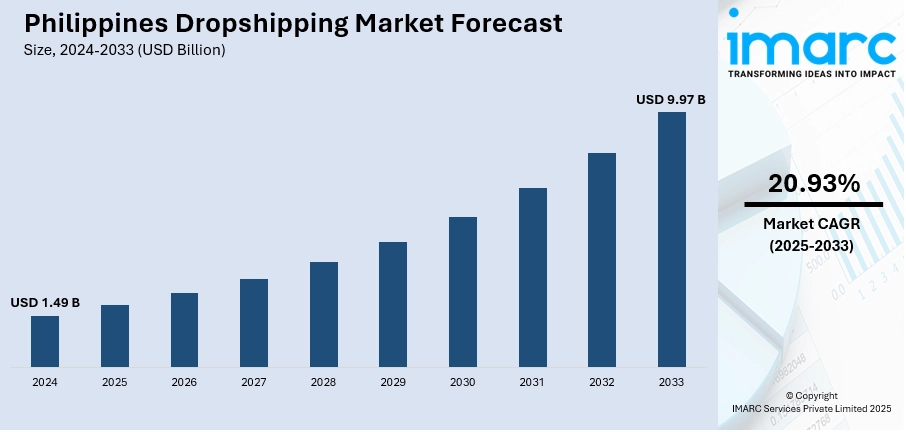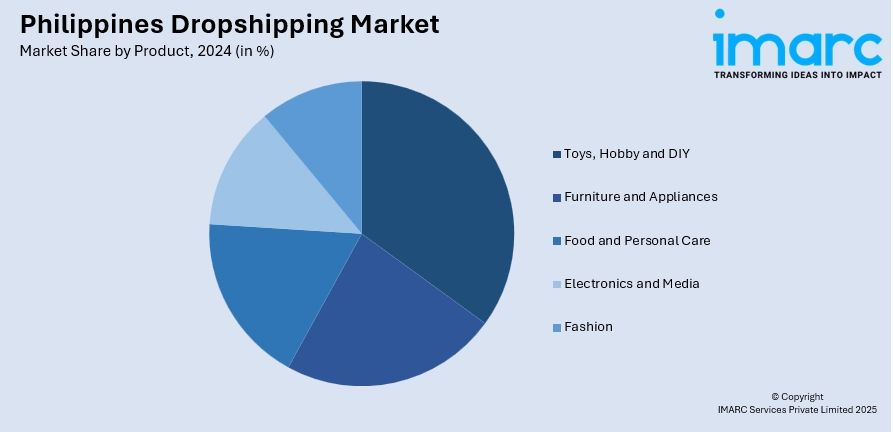
Philippines Dropshipping Market Size, Share, Trends and Forecast by Product and Region, 2025-2033
Philippines Dropshipping Market Overview:
The Philippines dropshipping market size reached USD 1.49 Billion in 2024. Looking forward, IMARC Group expects the market to reach USD 9.97 Billion by 2033, exhibiting a growth rate (CAGR) of 20.93% during 2025-2033. The country is witnessing fast growth in internet and smartphone adoption, which is fueling the market growth. Moreover, changing user behavior in the Philippines is driving the demand for convenience and a greater variety of products. Apart from this, the e-commerce environment of the country is experiencing tremendous improvements in infrastructure, which is expanding the Philippines dropshipping market share.
|
Report Attribute
|
Key Statistics
|
|---|---|
|
Base Year
|
2024
|
|
Forecast Years
|
2025-2033
|
|
Historical Years
|
2019-2024
|
| Market Size in 2024 | USD 1.49 Billion |
| Market Forecast in 2033 | USD 9.97 Billion |
| Market Growth Rate 2025-2033 | 20.93% |
Philippines Dropshipping Market Trends:
Growing Internet and Smartphone Penetration
The country is witnessing fast growth in internet and smartphone adoption, which is fueling the dropshipping business growth. Philippines has a total of 142 million active mobile users in the early 2025, as per Data Reportal. Digital connectivity is spreading geographically across urban and rural geographies. Filipinos increasingly spend more time online, especially on e-commerce sites and social media platforms, which are turning out to be leading drivers of product discovery and purchasing behaviors. This digital transformation is leading small businesses and entrepreneurs to embrace dropshipping as an easy, low-risk way into e-commerce, considering the little initial capital needed. E-commerce platforms such as Lazada and Shopee are also streamlining their platforms to accommodate this business model, providing integrated payment and logistics that ease the process for dropshippers. While mobile accessibility is getting better and digital literacy improves, more buyers and sellers are coming into the online space, driving the market in the country.

To get more information on this market, Request Sample
Increasing Demand for Ease and Products Variety
Changing user behavior in the Philippines is driving the demand for convenience and a greater variety of products. People are, in turn, looking for convenient online buying experiences that provide speed of delivery, secure payments, and access to local and overseas products. Dropshipping companies are taking advantage of this by providing varied product catalogs without inventory obligations, allowing listings of seasonal or trending products to be done at high speed, thereby impelling the Philippines dropshipping market growth. The flexibility is enabling sellers to react quickly to evolving needs, as people enjoy a wider range of products not usually carried by physical stores. Expansion in cashless transactions and efficient logistics networks is further complementing the customer experience, making online shopping more attractive to the mainstream market. As customers continue emphasizing variety and convenience, dropshipping models are flourishing by fulfilling these demands in a scalable and cost-efficient way.
Development of E-Commerce Infrastructure and Supporting Services
The e-commerce environment of the Philippines is experiencing tremendous improvements in infrastructure, which are actively complementing the development of the dropshipping business. These include the expansion of logistics networks, digital payment facilities, and government support for digital entrepreneurship. Local and global logistics companies are increasing delivery coverage and shortening shipping times, making it simpler for dropshipping businesses to ship orders in a timely manner. Meanwhile, fintech technologies like digital wallets and mobile banking are expanding financial inclusion, allowing more consumers to join the online shopping space. Government initiatives such as "Go Digital Pilipinas" are also promoting MSMEs to adopt digital transformation, with training and infrastructure that enhance e-commerce businesses. Such infrastructural development is eliminating historical entry obstacles for new vendors and enhancing the general efficiency and dependability of the supply chain. As this ecosystem continues to mature, it is enabling continued growth for dropshipping businesses in urban and provincial markets. IMARC Group predicts that the Philippines e-commerce market is projected to reach USD 75.59 Billion by 2033.
Philippines Dropshipping Market Segmentation:
IMARC Group provides an analysis of the key trends in each segment of the market, along with forecasts at the country and regional levels for 2025-2033. Our report has categorized the market based on product.
Product Insights:

- Toys, Hobby and DIY
- Furniture and Appliances
- Food and Personal Care
- Electronics and Media
- Fashion
The report has provided a detailed breakup and analysis of the market based on the product. This includes toys, hobby and DIY, furniture and appliances, food and personal care, electronics and media, and fashion.
Regional Insights:
- Luzon
- Visayas
- Mindanao
The report has also provided a comprehensive analysis of all the major regional markets, which include Luzon, Visayas, and Mindanao.
Competitive Landscape:
The market research report has also provided a comprehensive analysis of the competitive landscape. Competitive analysis such as market structure, key player positioning, top winning strategies, competitive dashboard, and company evaluation quadrant has been covered in the report. Also, detailed profiles of all major companies have been provided.
Philippines Dropshipping Market Report Coverage:
| Report Features | Details |
|---|---|
| Base Year of the Analysis | 2024 |
| Historical Period | 2019-2024 |
| Forecast Period | 2025-2033 |
| Units | Billion USD |
| Scope of the Report |
Exploration of Historical Trends and Market Outlook, Industry Catalysts and Challenges, Segment-Wise Historical and Future Market Assessment:
|
| Products Covered | Toys, Hobby and DIY, Furniture and Appliances, Food and Personal Care, Electronics and Media, Fashion |
| Regions Covered | Luzon, Visayas, Mindanao |
| Customization Scope | 10% Free Customization |
| Post-Sale Analyst Support | 10-12 Weeks |
| Delivery Format | PDF and Excel through Email (We can also provide the editable version of the report in PPT/Word format on special request) |
Key Questions Answered in This Report:
- How has the Philippines dropshipping market performed so far and how will it perform in the coming years?
- What is the breakup of the Philippines dropshipping market on the basis of product?
- What is the breakup of the Philippines dropshipping market on the basis of region?
- What are the various stages in the value chain of the Philippines dropshipping market?
- What are the key driving factors and challenges in the Philippines dropshipping market?
- What is the structure of the Philippines dropshipping market and who are the key players?
- What is the degree of competition in the Philippines dropshipping market?
Key Benefits for Stakeholders:
- IMARC’s industry report offers a comprehensive quantitative analysis of various market segments, historical and current market trends, market forecasts, and dynamics of the Philippines dropshipping market from 2019-2033.
- The research report provides the latest information on the market drivers, challenges, and opportunities in the Philippines dropshipping market.
- Porter's five forces analysis assist stakeholders in assessing the impact of new entrants, competitive rivalry, supplier power, buyer power, and the threat of substitution. It helps stakeholders to analyze the level of competition within the Philippines dropshipping industry and its attractiveness.
- Competitive landscape allows stakeholders to understand their competitive environment and provides an insight into the current positions of key players in the market.
Need more help?
- Speak to our experienced analysts for insights on the current market scenarios.
- Include additional segments and countries to customize the report as per your requirement.
- Gain an unparalleled competitive advantage in your domain by understanding how to utilize the report and positively impacting your operations and revenue.
- For further assistance, please connect with our analysts.
 Request Customization
Request Customization
 Speak to an Analyst
Speak to an Analyst
 Request Brochure
Request Brochure
 Inquire Before Buying
Inquire Before Buying




.webp)




.webp)












